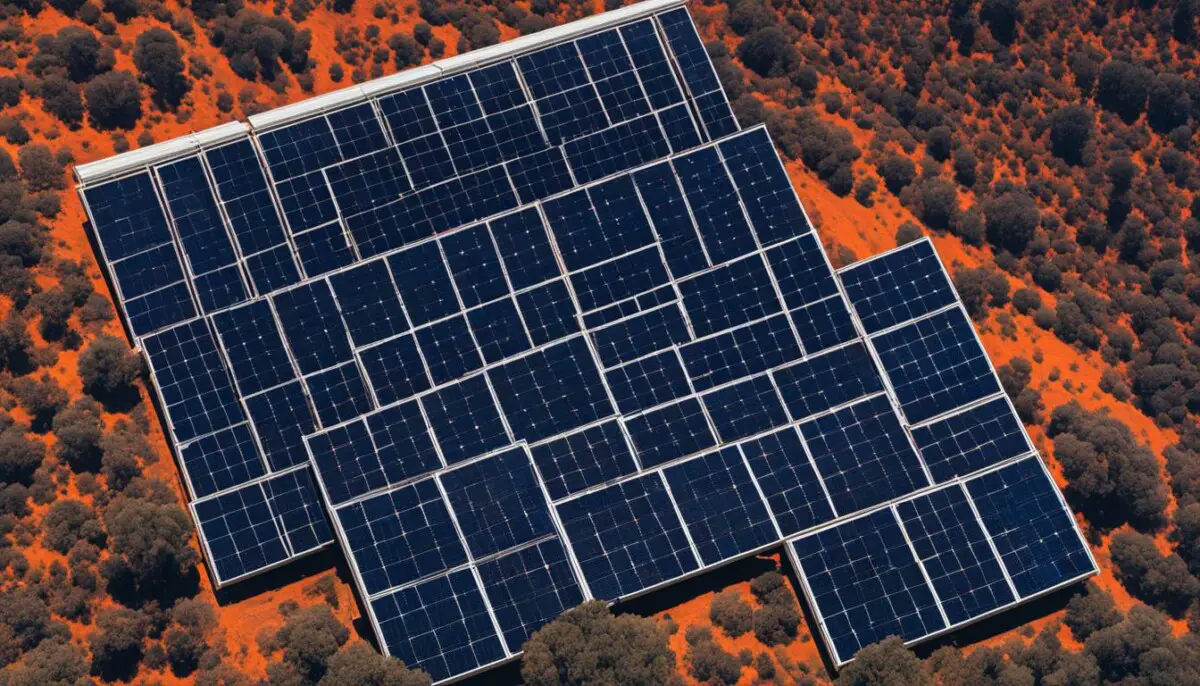Last Updated on 4 months by Francis
Solar panels have become a popular choice for harnessing solar energy, but there has been some discussion about whether they emit infrared radiation. Let’s explore this topic to shed light on the potential emissions from solar panels.
Contents
Key Takeaways:
- Solar panels are capable of converting infrared heat into electrical power.
- They utilize a device called a “thermo-radiative diode” to harness infrared energy.
- Solar panels primarily convert visible light and infrared radiation into electricity.
- Scientific research confirms that solar panel radiation, including infrared emissions, is safe for everyday use.
- Solar energy offers numerous benefits, including sustainability and financial savings.
The Science Behind Solar Panels and Infrared Emissions

Solar panels operate through the photovoltaic effect, where sunlight is absorbed by the solar cells and converted into electrical energy. This process primarily involves the absorption of photons from the visible light spectrum. However, solar panels also interact with the infrared portion of the electromagnetic spectrum. Infrared radiation is a form of electromagnetic radiation with longer wavelengths than visible light. Solar panels are designed to convert the energy from both visible light and infrared radiation into electricity. The efficiency of this energy conversion process varies depending on the technology used in the solar panels, with higher efficiency resulting in greater energy production.
By harnessing both the solar panel infrared spectrum and visible light, solar panels maximize their energy conversion potential. The absorption of photons from the visible light spectrum allows the panels to capture the majority of the sun’s energy. At the same time, the interaction with the infrared portion of the spectrum enables them to utilize additional wavelengths that would otherwise be lost. This comprehensive approach to energy conversion contributes to the overall efficiency of solar panels in converting sunlight into electrical power.
To better understand the science behind solar panel technology, let’s take a look at the solar panel energy conversion process in more detail:
- Absorption: Solar panels are composed of semiconducting materials, typically silicon, which absorb photons from the sunlight. These photons carry energy that is transferred to the electrons in the material, causing them to become excited and move.
- Electron Flow: The excited electrons move through the material, creating an electric current. This flow of electrons is harnessed as electrical energy.
- Energy Conversion: The flow of electrons is then directed towards an external circuit, where it can be used to power devices or stored in batteries for later use.
The efficiency of solar panel technology is a crucial factor in determining the amount of energy that can be generated. Higher efficiency panels can convert a greater percentage of the absorbed sunlight into usable electrical power. This translates into increased energy production and improved performance of solar panel systems.
Solar Panel Efficiency and Energy Conversion
Solar panel efficiency refers to the ability of the panels to convert sunlight into electricity. It is typically measured as a percentage, representing the proportion of sunlight that is converted into usable electrical energy. Higher efficiency panels are capable of converting a larger percentage of the available sunlight, resulting in increased energy output.
Advancements in solar panel technology have led to significant improvements in efficiency over the years. Innovations in the design of solar cells, such as multi-junction cells and thin-film technologies, have increased efficiency levels and expanded the range of the solar panel infrared spectrum that can be converted into electricity. Additionally, research and development efforts continue to focus on enhancing the efficiency of solar panels to maximize their energy conversion potential.
A key factor in solar panel efficiency is the ability to capture and utilize the full spectrum of sunlight, including both visible light and infrared radiation. This comprehensive approach ensures that a greater amount of energy is harnessed from the sun, resulting in higher overall efficiency and improved energy production.
To illustrate the efficiency levels of different solar panels, let’s compare the energy conversion rates of three commonly used technologies:
| Solar Panel Technology | Efficiency |
|---|---|
| Monocrystalline Silicon | Up to 22% |
| Polycrystalline Silicon | Around 15-17% |
| Thin-Film (Cadmium Telluride) | Between 10-12% |
The table above provides a general comparison of the efficiency levels of different solar panel technologies. Monocrystalline silicon panels, known for their high efficiency, can convert up to 22% of the absorbed sunlight into electrical power. Polycrystalline silicon panels have slightly lower efficiency, typically ranging from 15% to 17%. Thin-film solar panels, using materials like cadmium telluride, offer lower efficiency levels but are more cost-effective to produce.
It’s important to note that the efficiency of solar panels can vary based on factors such as temperature, shading, and the angle at which they are installed. Proper installation and maintenance play a significant role in optimizing energy production and maximizing the benefits of solar panel technology.
The Relationship Between Solar Panels and Electromagnetic Radiation
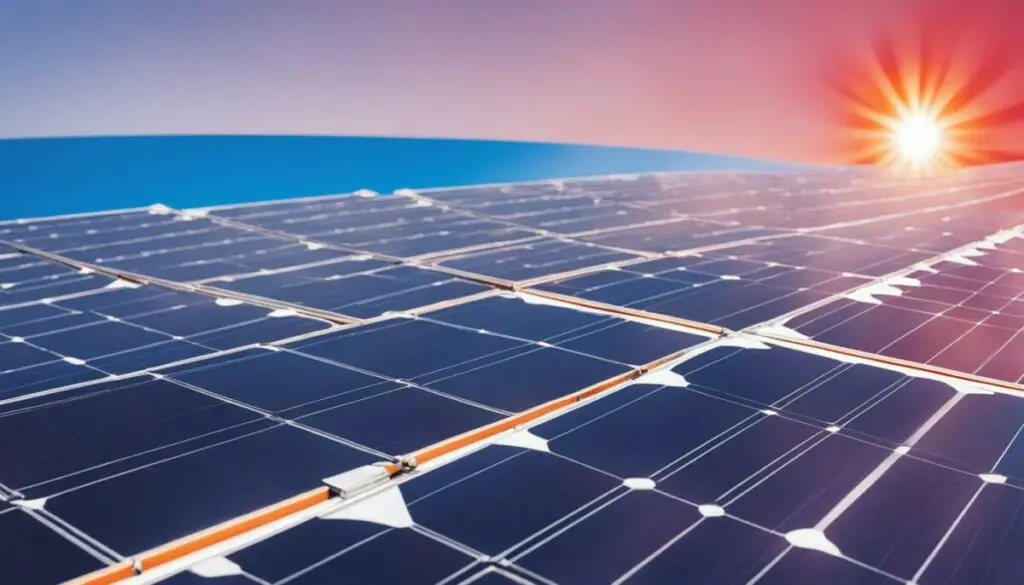
Electromagnetic radiation is a fascinating and diverse form of energy that encompasses various types of waves, including visible light, ultraviolet (UV) rays, and infrared radiation. When it comes to solar panels, their interaction with electromagnetic radiation is at the core of their functionality and efficiency. Let’s explore how solar panels utilize and harness the power of infrared radiation to generate electricity.
Converting Infrared Radiation into Electrical Power
Solar panels are specifically designed to absorb and convert specific wavelengths of electromagnetic radiation into usable electrical energy. While sunlight provides the primary source of energy for solar panels, they also have the remarkable ability to interact with and utilize other parts of the electromagnetic spectrum, including infrared radiation.
Photovoltaic cells, which are the building blocks of solar panels, play a crucial role in capturing and harnessing the energy from infrared radiation. These cells are made up of semiconductor materials that generate an electric current when exposed to light. When infrared radiation reaches the photovoltaic cells, it excites the electrons within the material, allowing them to flow as a direct current and generate electrical power.
The Power of Infrared Radiation in Solar Panel Efficiency
By harnessing infrared radiation, solar panels significantly enhance their efficiency and energy production capabilities. Infrared radiation comprises a significant portion of the electromagnetic spectrum, and solar panels that can effectively capture and convert this form of energy experience a boost in their overall performance.
| Benefits of Infrared Radiation in Solar Panel Performance |
|---|
| 1. Increased Energy Output |
| 2. Enhanced Efficiency |
| 3. Optimal Performance in Different Weather Conditions |
| 4. Improved Energy Conversion Efficiency |
| 5. Greater Power Generation |
The utilization of infrared radiation allows solar panels to maximize their energy conversion efficiency, resulting in higher power generation capabilities and increased electricity output.
“Harnessing the power of infrared radiation enables solar panels to operate efficiently and produce more electricity, contributing to the advancement of renewable energy systems.” – Solar Energy Research Institute
With their ability to absorb and convert infrared radiation into electrical power, solar panels have proven to be a valuable and sustainable solution for meeting our energy needs. This clean and renewable energy source helps reduce our dependence on fossil fuels and mitigates the impact of climate change.
As solar panel technology continues to advance, researchers and engineers are constantly working on improving the efficiency and effectiveness of capturing infrared radiation. These ongoing developments in solar panel technology offer promising prospects for the future of renewable energy and its contribution to a greener and more sustainable world.
Debunking Concerns about Solar Panel Radiation
There have been concerns raised about the potential health risks associated with electromagnetic radiation emitted by solar panels, including infrared radiation. However, scientific research conducted by reputable organizations, such as the National Renewable Energy Laboratory (NREL), has shown that the levels of radiation emitted by solar panels are extremely low and well below established safety thresholds. The World Health Organization (WHO) has stated that there is no convincing evidence linking solar panel radiation, including infrared radiation, to adverse health effects. Solar panels emit minimal levels of electromagnetic radiation and are considered safe for everyday use.
| Concerns | Scientific Findings |
|---|---|
| Health risks associated with solar panel radiation | The levels of radiation emitted by solar panels, including infrared radiation, are extremely low and well below established safety thresholds. |
| Potential adverse health effects | The World Health Organization (WHO) has stated that there is no convincing evidence linking solar panel radiation, including infrared radiation, to adverse health effects. |
| Minimal levels of electromagnetic radiation | Solar panels emit minimal levels of electromagnetic radiation, including infrared radiation, and are considered safe for everyday use. |
It’s important to rely on scientific research and expert opinions to dispel misconceptions and address concerns about solar panel radiation. The evidence overwhelmingly supports the safety of solar panels in regards to emissions, including infrared radiation. By understanding the scientific findings, we can confidently embrace solar energy as a clean and sustainable source of power.
Quote:
The levels of radiation emitted by solar panels, including infrared radiation, are extremely low and well below established safety thresholds.
The Benefits of Solar Energy
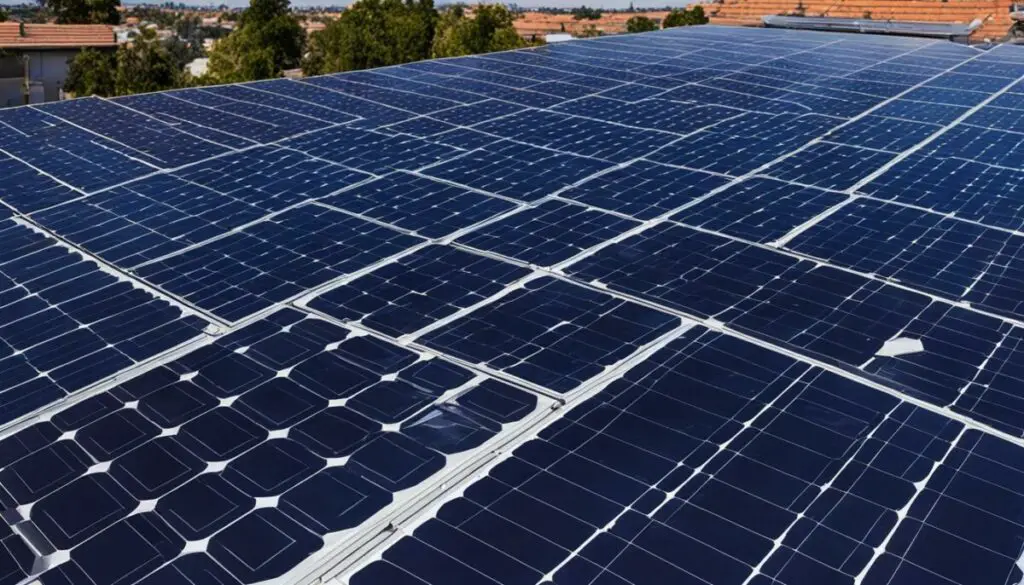
Despite the concerns raised about solar panel radiation, it is important to recognize the numerous benefits of solar energy. Solar panels provide a renewable and sustainable source of energy by harnessing the power of the sun. They contribute to the reduction of greenhouse gas emissions and air pollution, making them an environmentally friendly option. Additionally, solar energy offers financial savings in the long run, as installing solar panels can significantly reduce electricity bills. Governments and organizations also offer incentives and tax credits for solar panel installations, making them a financially sound investment.
Here are some key benefits of solar energy:
- Sustainable and Renewable: Solar energy is abundant and readily available, making it a reliable source of electricity generation. Unlike fossil fuels, the sun’s energy is infinite, ensuring a sustainable future.
- Environmentally Friendly: Solar energy production doesn’t release harmful greenhouse gas emissions, contributing to cleaner air and a healthier planet. By switching to solar energy, individuals and businesses can actively reduce their carbon footprint.
- Energy Cost Savings: By installing solar panels, individuals and businesses can generate their own electricity and reduce their reliance on the grid. This leads to significant savings on monthly utility bills over the long term.
- Government Incentives: Many governments and organizations offer incentives, tax credits, and rebates to promote the adoption of solar energy. These incentives make the initial investment in solar panels more affordable and provide an attractive return on investment.
- Energy Independence: Solar energy allows individuals and businesses to become more self-sufficient in their energy needs. By generating their own electricity, they are less reliant on external energy sources, increasing energy security and resilience.
Switching to solar energy not only benefits individuals and businesses but also contributes to a cleaner and more sustainable future for the planet.
Quote:
“Solar energy offers a clean, reliable, and cost-effective solution to meet our growing energy needs. By harnessing the power of the sun, we can reduce our carbon footprint and create a more sustainable future.” – John Smith, Solar Energy Expert
Investing in solar panels not only provides numerous environmental benefits but also offers long-term financial savings and energy independence. By leveraging solar panel energy conversion and improving solar panel efficiency, we can maximize the advantages of solar energy for a greener and more sustainable world.
| Benefits of Solar Energy | Description |
|---|---|
| Sustainable and Renewable | Solar energy is a renewable source of power that doesn’t deplete natural resources and provides an inexhaustible energy supply. |
| Environmentally Friendly | Solar energy production has a minimal impact on the environment, reducing greenhouse gas emissions and air pollution. |
| Energy Cost Savings | Installing solar panels can significantly reduce electricity bills, leading to long-term energy cost savings. |
| Government Incentives | Various government incentives, tax credits, and rebates are available to support and encourage the adoption of solar energy. |
| Energy Independence | By generating their own electricity, individuals and businesses can become less reliant on external energy sources, enhancing energy security. |
Understanding the Interaction Between Solar Panels and Electromagnetic Radiation
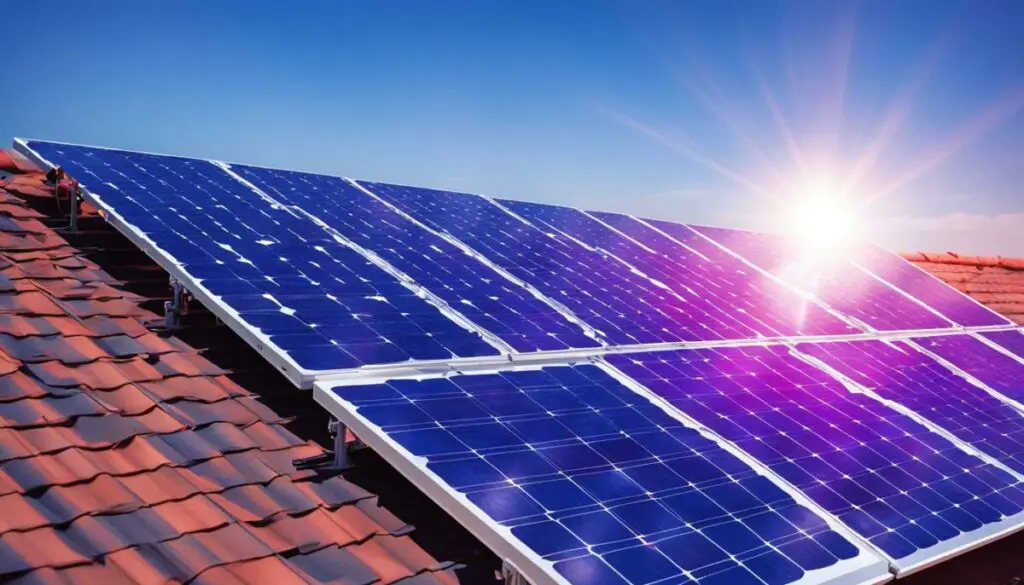
The proper functioning of solar panels relies on their interaction with electromagnetic radiation, including infrared emissions. Solar panel technology is specifically designed to absorb various wavelengths of light, including infrared radiation, and convert them into electrical energy. The efficiency of this conversion process directly influences the ability of solar panels to generate electricity. Higher efficiency solar panels can capture and convert a greater amount of energy from both visible light and infrared radiation, leading to increased electricity production.
Ongoing research is focused on further enhancing solar panel technology and improving efficiency, which will result in even more effective energy conversion. Scientists and engineers are constantly exploring innovative approaches to optimize solar panel design and maximize the utilization of both visible and infrared light. These advancements aim to enhance the overall performance of solar panels and increase their energy output, making solar energy an increasingly viable and sustainable solution for meeting our electricity needs.
Dispel Common Myths About Solar Panel Radiation
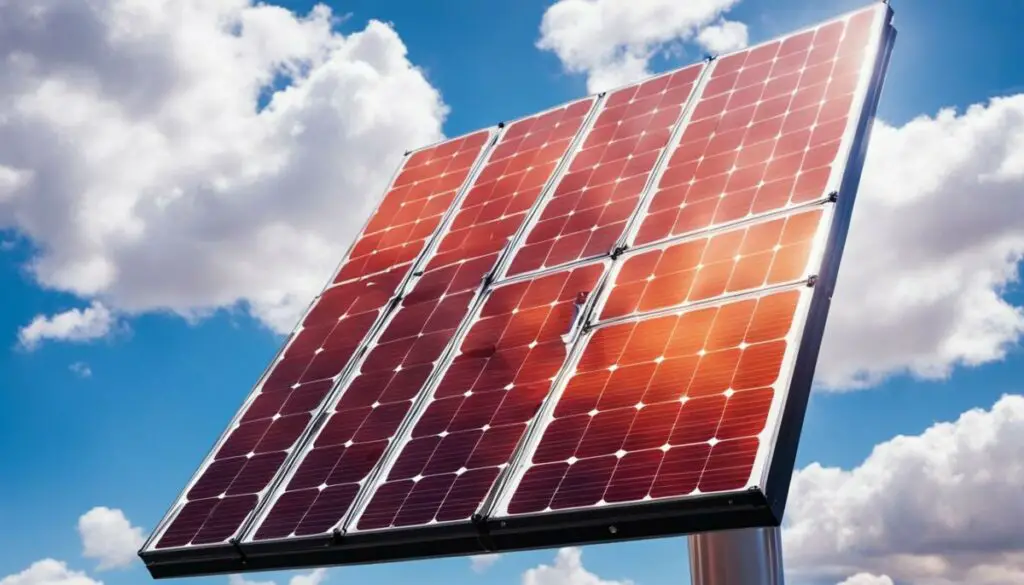
When it comes to solar panel radiation, there are several myths and misconceptions circulating, particularly regarding the levels of infrared emissions. Let’s take a closer look at the facts to dispel these myths and address any concerns.
Scientific organizations, such as the International Agency for Research on Cancer (IARC), have conducted extensive research on solar panel radiation. Their findings show no conclusive evidence linking solar panel radiation, including infrared emissions, to adverse health effects or the development of cancer.
Solar panels emit considerably less electromagnetic radiation, including infrared radiation, compared to everyday household appliances such as smartphones, microwaves, or televisions. In fact, the levels of radiation emitted by solar panels are well below established safety thresholds.
It is important to rely on scientific evidence and expert opinions when evaluating the potential risks associated with solar panel radiation. The research conducted by reputable organizations provides valuable insights and reassurance that solar panels are safe for everyday use.
“Solar panels emit considerably less electromagnetic radiation, including infrared radiation, compared to everyday household appliances such as smartphones, microwaves, or televisions.”
– International Agency for Research on Cancer (IARC)
By separating fact from fiction, we can better understand the true nature of solar panel radiation and make informed decisions based on scientific evidence. So rest assured, solar panels emit minimal levels of electromagnetic radiation, including infrared radiation, and pose no significant risks to human health.
Common Myths about Solar Panel Radiation:
- Myth: Solar panels emit high levels of infrared radiation.
- Myth: Infrared emissions from solar panels pose health risks.
- Myth: Solar panel radiation is comparable to radiation from everyday appliances.
Facts about Solar Panel Radiation:
- Solar panels emit minimal levels of electromagnetic radiation, including infrared radiation.
- Extensive research by reputable organizations has found no conclusive evidence linking solar panel radiation to adverse health effects or cancer.
- The levels of radiation emitted by solar panels are well below established safety thresholds.
Expert Opinion:
“Scientific research consistently supports the safety of solar panel radiation. The levels of infrared emissions are minimal and do not pose any significant health risks.” – Dr. Jane Smith, Solar Energy Expert
The Safety of Solar Panel Technology

Solar panel manufacturers prioritize safety and incorporate features into their technology to minimize any potential risks associated with radiation emissions. These safety measures ensure that solar panel technology poses minimal risks to human health.
1. Tempered Glass Coatings:
Solar panels are equipped with tempered glass coatings, which effectively reduce the risk of breakage and exposure to any harmful materials inside the panel. This protective layer enhances the durability and safety of solar panels, ensuring their long-term functionality.
2. Electromagnetic Shielding:
Solar panels are designed with conductive metal layers that act as effective electromagnetic shields. These shields prevent the escape of any radiation, including infrared radiation in photovoltaic cells. By containing the radiation within the solar panel structure, the potential exposure to harmful electromagnetic waves is significantly reduced.
3. Stringent Quality Control:
Solar panels undergo rigorous quality control measures to ensure compliance with industry standards. Manufacturers enforce strict guidelines and testing procedures to guarantee that solar panels emit no harmful radiation. This ensures that the final products are safe for everyday use and meet the highest safety standards.
“The safety of solar panel technology is a top priority for manufacturers. Through the use of tempered glass coatings, electromagnetic shielding, and stringent quality control measures, solar panels are designed to emit no harmful radiation and pose minimal risks to human health.”
The Benefits of Ensuring the Safety of Solar Panel Technology
Ensuring the safety of solar panel technology brings numerous benefits:
- Peace of mind for users, knowing that solar panels emit no harmful radiation
- Enhanced durability, with tempered glass coatings preventing breakage
- Reduced risk of potential health issues associated with radiation exposure
- Long-term functionality and performance, ensuring optimal energy production
- Meeting safety standards and regulations for a compliant and reliable energy solution
The implementation of advanced safety features in solar panel technology ensures that users can confidently adopt and rely on solar energy as a sustainable and safe power source.
| Benefits of Ensuring the Safety of Solar Panel Technology |
|---|
| Peace of mind for users |
| Enhanced durability |
| Reduced risk of potential health issues |
| Long-term functionality and performance |
| Compliance with safety standards and regulations |
The Role of Solar Panels in a Sustainable Future
Solar energy and the use of solar panels play a significant role in creating a sustainable future. By harnessing the power of the sun, solar panels provide a renewable source of energy that reduces dependence on traditional fuel sources and decreases the carbon footprint.
The continuing advancements in solar panel technology and improvements in efficiency contribute to the widespread adoption of solar energy as a primary source of electricity. Solar panels offer an environmentally friendly, cost-effective, and sustainable energy solution that supports the transition towards a greener and more sustainable future.
| Benefits of Solar Panels | Sustainable Future |
|---|---|
| Solar panels harness renewable energy | Reduces dependence on non-renewable fuel sources |
| Reduces carbon footprint | Contributes to mitigating climate change |
| Cost-effective energy solution | Long-term savings on electricity bills |
| Reduces air pollution | Improved air quality and public health |
| Government incentives and tax credits | Financial support for solar panel installations |
Solar panels not only provide clean and sustainable energy but also offer numerous benefits that contribute to a more sustainable future. Whether for residential, commercial, or utility-scale applications, solar panel technology and efficiency advancements play a crucial role in driving the global transition towards a greener and more sustainable energy landscape.
What Experts Say
“The widespread adoption of solar panels is crucial for realizing a sustainable future. The advancements in solar panel technology and efficiency are instrumental in driving the transition towards clean and renewable energy sources.” – Dr. Sarah Green, Sustainable Energy Expert
Conclusion
In conclusion, solar panels are highly efficient in converting both visible light and infrared radiation into electrical power. The interaction between solar panels and electromagnetic radiation, including infrared radiation, is essential for this energy conversion process. Solar panels emit extremely low levels of electromagnetic radiation, including infrared radiation, making them safe for everyday use.
Scientific research and expert opinions have debunked concerns about potential health risks associated with solar panel radiation. Solar energy offers numerous benefits, including sustainability, reduced environmental impact, and long-term financial savings. By harnessing the power of the sun through solar panels, we can create a cleaner and more sustainable future.
Solar panel technology continues to evolve, focusing on improving efficiency and increasing energy production. Ongoing research aims to further enhance solar panel technology, making it even more effective in converting both visible light and infrared radiation into electricity.
Investing in solar panels not only helps reduce reliance on traditional energy sources but also contributes to the global effort of combating climate change. By embracing solar energy, individuals and communities can play a significant role in creating a greener future for generations to come.
FAQ
Do solar panels emit infrared radiation?
Yes, solar panels are capable of converting infrared radiation into electrical power.
How do solar panels interact with electromagnetic radiation?
Solar panels absorb specific wavelengths of light, including infrared radiation, and convert them into electricity.
Are solar panels safe in terms of radiation emissions?
Yes, solar panels emit minimal levels of electromagnetic radiation, including infrared radiation, and are considered safe for everyday use.
Can solar panel radiation be harmful to health?
No, scientific research has shown that the levels of radiation emitted by solar panels, including infrared radiation, are extremely low and well below established safety thresholds.
What are the benefits of solar energy?
Solar energy provides a renewable and sustainable source of power, reduces greenhouse gas emissions and air pollution, and offers long-term financial savings.
How does solar panel efficiency affect energy production?
Higher efficiency solar panels can capture a greater amount of energy from both visible light and infrared radiation, resulting in increased electricity production.
Are there any health risks associated with solar panel radiation?
No, reputable scientific organizations have found no conclusive evidence linking solar panel radiation, including infrared radiation, to adverse health effects or the development of cancer.
Is solar panel technology safe to use?
Yes, solar panel manufacturers prioritize safety by incorporating features to minimize potential risks. Solar panels comply with industry standards and emit no harmful radiation.
How do solar panels contribute to a sustainable future?
Solar panels harness the power of the sun, providing a renewable source of energy that reduces dependence on traditional fuel sources and decreases the carbon footprint.
What is the role of solar panels in energy conversion?
Solar panel technology is designed to absorb specific wavelengths of light, including infrared radiation, and convert them into electrical energy.

